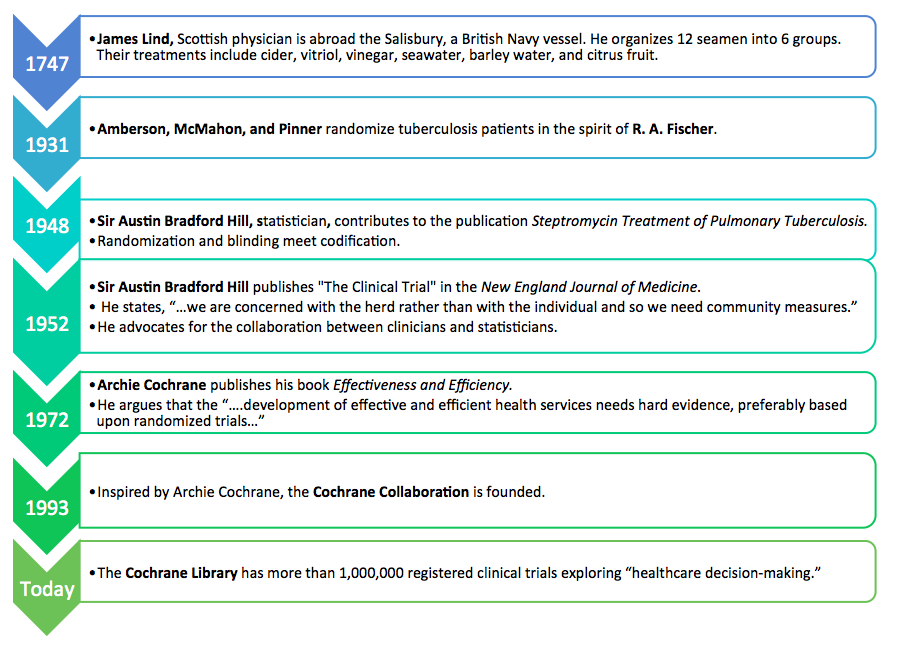Historically, medically-oriented research has dominated the ethical discussions that underlie federal regulations around human subjects protections.
For example, despite starting to conduct randomized controlled trials (RCTs)—often referred to as the “gold standard” of biomedical research—at roughly the same time as biomedical researchers, legal researchers did not continue to pursue RCTs in the same capacity. As D. James Greiner and Andrea Matthew note in their 2016 article “Randomized Control Trials in the United States Legal Profession” in the Annual Review of Law and Social Science, though the first randomized process in a legal setting occurred in 1933—a mere two years after Fischer’s randomization—there appear to have only ever been 50 RCTS conducted in the legal profession since then (as Greiner and Matthew show in a chronological table).
So, in the words of Greiner and Matthew“…each law RCT appears to be a unicorn, a magical creation with no origin story that appears briefly in a larger setting and then fades away.”
RCTs: A brief biomedical history
Those working in Law, along with education and other disciplines, are just beginning to explore RCTs as a core part of their methodological toolkit, and as they do IRBs face the challenge of reviewing this type of study in these realms.
Social Scientists and IRBs
“Socrates himself would probably roll over in his grave if he knew about the hoops his academic heirs in the humanities, law, and the social sciences have been jumping through in recent decades to even gain permission to ask questions, including the requirement for vetting of questions by a review board before they get asked. When the regulatory system was first launched in the 1970s, many scholars fought the good fight, but they lost the battle to protect low-risk social-science research activities from bureaucratic surveillance, project licensing, and the power of prior restraint granted to IRB committees.”
Richard A. Shweder and Richard E. Nisbett, Long-Sought Research Deregulation Is Upon Us. Don’t Squander the Moment in The Chronicle of Higher Education, 2017
Regardless of the historically tenuous relationship between IRBs and social scientists, research continues to evolve. Thus, IRBs are challenged with reviewing RCTs in fields that are in their infancy of developing this type of research.
So, with biomedically-oriented regulations as well as other longstanding challenges, how can IRBs adapt to these “unicorns”?
- Transparency: The IRB process can sometimes be viewed externally as a “black box.” IRBs and researchers can acknowledge the tensions between IRBs and researchers—and the new challenges posed—by adapting to a new methodology. Optimistically, by providing a more communicative process, previous assumptions and misgivings can be mended.
- Education: The ethical debate within RCT researchers concerning clinical equipoise—the idea that a new treatment may improve a genuinely uncertain condition—is longstanding. IRBs and researchers can engage in a conversation about their disciplines, methodologies, and history, setting a stage for meaningfully understanding the purpose of the study. The participant’s experience and risk can then be thoughtfully assessed.
- Flexibility: Unicorns are elusive. Where RCTs are uncommon, perspective and flexibility are critical. IRBs see a range of submissions from varying disciplines. While some fields are new to RCTs, some are not. Without compromising the protection of participants, IRBs can observe regulations while openly approaching new proposals with historical insight and creativity.
During the emergence of RCTs in the biomedical realm, Sir Bradford Hill advocated for the collaborative effort between clinicians and statisticians. In recognition of the emergence of RCTs in the social sciences today, partnerships between researchers and IRBs are critical.
In his lectures on being a Citizen-Scientist and approaching doubt and uncertainty, Richard Feynman said, “All scientific knowledge is uncertain. This experience with doubt and uncertainty is important. I believe that it is of very great value, and one that extends beyond the sciences. I believe that to solve any problem that has never been solved before, you have to leave the door to the unknown ajar.”
After all, how else are we going to make room for unicorns?
Tonya Ferraro is a Senior IRB Administrator at Harvard University and a member of the PRIM&R Emerging Professionals Working Group.


No comments! Be the first commenter?